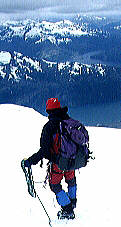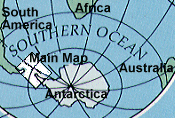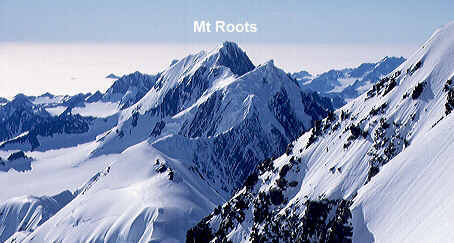
![]()
.
.
.
.
.
.
.
.
.
.
.
.
.
.
.
.
.
.
.
.

![]()

[
Logbook Index ]

Log
Entry for week to 23 February 1997
Click map for detailed
chart
Attempt on Mount Roots
|
|
|
. The 7483 foot summit of Mt Roots still remains virgin after two attempts during the last few days. Royal Marine Sargeant Colin Hearn, the mountain leader for the garrison at Grytviken, and I had the first go. At 1230 on February 19th we were dropped off (inserted would be the combat term!) by one of the army's 'Rigid Raider' assault boats at the foot of the Nordenskjold Glacier which tumbles into the sea. In the meantime Pelagic had gone to whaling station at Stromness to complete some filming for the forthcoming documentary in Ireland. 'Cole,' a very fit 35 year old, marched off up the glacier with me in hot pursuit. Six weeks of inactivity on Pelagic (in mountain fitness terms) had done me no good and I immediately felt the strain of the very heavy rucsac filled with climbing equipment, our tent, five days food and various pieces of clothing. All up it which must have weighed in at 30 kg. Four hours later we reached our first camp at the foot of the ridge that sweeps in an arc up to the eastern summit of Mt Roots. Our camp was only 350 meters above sea level but 10 kilometers up the glacier, the way marked clearly on the blue ice by a medial moraine of shattered black rock, a curious feature when seen from higher up as it looks like someone drew it on the ice with a pencil. We pitched camp at the base of this ridge, had a meal and turned in early with the wind rattling the tent in periodic gusts coming down from the peaks above. Mt. Roots is the the last unclimbed summit above 7000 feet on South Georgia. Stephen Venables 1989 Southern Ocean Mountaineering Expedition attempted it three times but were repeatedly thwarted by bad weather. More recently it has been tried by a succession of the Royal Marine mountain leaders who are stationed here for a four month term of duty. They had all failed due to atrocious weather. Our forecast, on the other hand was predicted to be a rare period of stability with high pressure dominating the area. I experienced a similar condition here in 1994 when I was lucky enough to climb Mt Paget, the highest peak on South Georgia at 9600 feet. This was only the fourth ascent of Paget, not a technically difficult route, but like all the climbing here, complicated and demanding because of the savage winds that suddenly spring up out of an innocuously clear sky. With all this in mind, Cole and I were confident of getting to the top of Mt Rootes IF the weather held. On February 20th we were off by 0900. Four hours later after negotiating an easy icefall to the upper basin, our New Zealand made 'Macpac' Olympus two man tent was erected in a snow pit dug deep enough to get the peak of the tent below snow level. The superb weather was holding. Earlier, while we were trudging up the glacier, we began to realize why Mt Roots had never been climbed before. Most of the north face was guarded by overhanging ice cliffs and the one buttress that was 'safe' looked reasonably steep and complicated consisting of rock marbled with several ice gullies offering various possibilities. None looked a pushover. Pessimism seems to be the order of the day when climbing on South Georgia - its better never to let your hopes run too high. But when we woke up at 0400 (late by alpine standards) it was clear and calm and with a full moon setting in the western sky. After a brew and cup of hot oats (army ration) we were off across the snow basin, stepping through the last snow up to mid calf. In the morning light we picked a couloir, crossed the bergshrund (a crack or crevasse seperating the ice of the glacier from the mountain proper) and began to run out the rope, front pointing on our crampons up the steep ice and snow. The technique here is to attempt to attach 'runners' onto the adjacent rock (metal nuts and wedges) to run the rope through to protect ourselves from a fall or more to the point, rockfall. After six pitches rising 200 meters we realized the folly of our enterprise: the rock was rotten, that is it had the consistency of a slag heap and the 'placements' for runners were too few, the snow was loose under foot, rocks and pieces of ice were continually bombarding us from aloft - all this coupled with a grade of 50 degrees and the fact that moving as slow as we were would mean overnighting somehwere near the top of the mountain, if we could find a way to the top at all. We retreated carefully, secure in the knowledge we had done the right thing (Cole is a family man with a wife and two kids) and pleased we had a made a good try and rubbed our noses in it. My conclusion is that the buttress could be a superb winter climb when the mountain is plastered with ice, the loose rock locked in and the conditions underfoot safe enough to move quickly unroped. There's also the possibility of the unexplored south side of the mountain. . . . another time. We slogged back to camp and spent a lovely afternoon admiring the view. Later that afternoon Frank Nugent and Paddy Barry joined us, having come up from the shore in one long day. We explained the situation, gave them a cup of tea and helped them dig out their tent platform. The next morning Cole and I headed down, leaving the pair to have another try if the weather held. They repeated our gully, but found the same problems, plus the weather closed in that afternoon and snowed throughout the night. The next day they bailed out back down the Nordenskjold as well. We are nearing the end of our stay in South Georgia with only a week to go. Possibly we will investigate the other side of the island, or possibly leave early to spend more time in Tierra del Fuego. Its a committee decision and the committee is still out on that one. Skip Novak |

